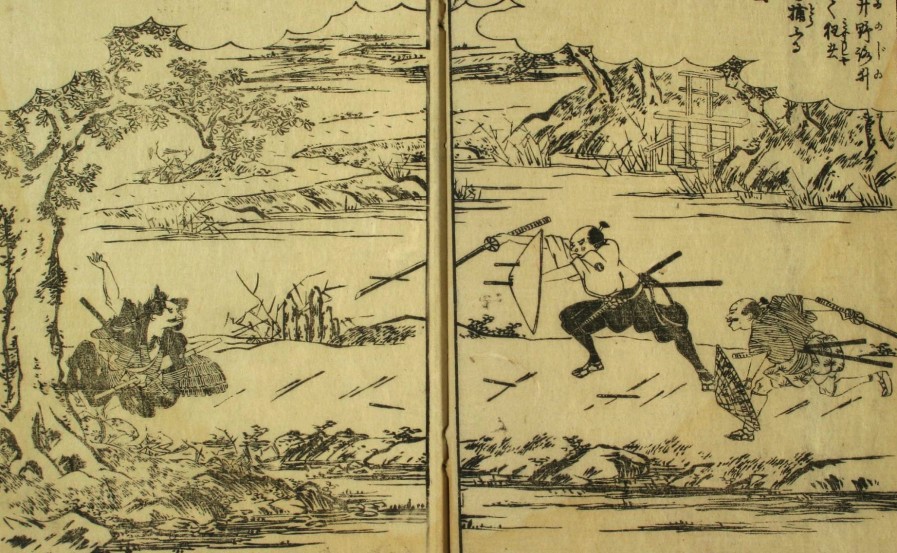
Sticks and stones were some of the first weapons used by human beings, and it’s certain that early tribes used thrown stones to knock down enemies at short, medium and even long distances with the help of throwing devices such as slings.
In Japan in ancient times, this art was called Hoseki (抛石), and later texts such as the Heike Monogatari (平家物語) and the Gikeiki (義経記) recorded it as inji (印地) *1, something that ultimately evolved into stone-throwing battles (石合戦). Over time, the stones used for this purpose evolved into simple square metal plates, and later more elaborately shaped metal projectiles.
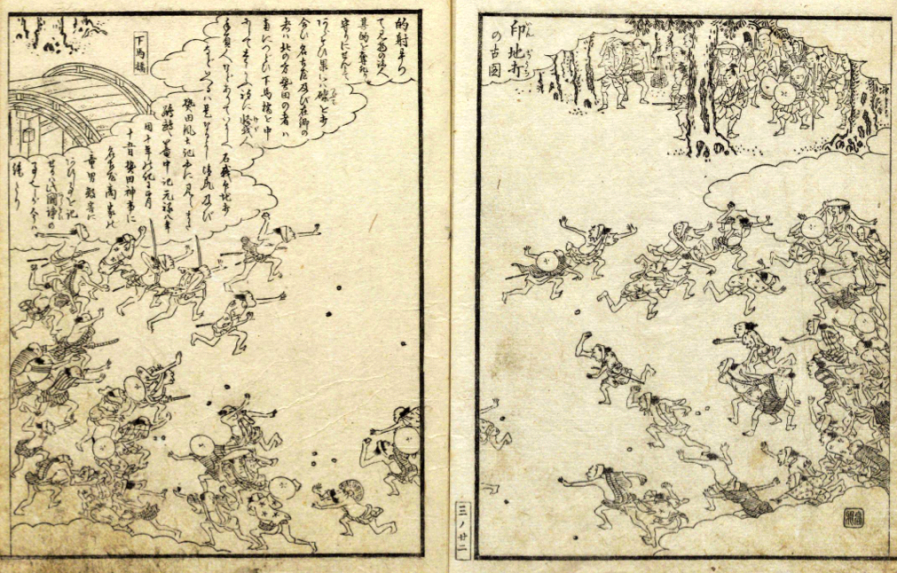
‘Picture of the Stone-throwing Battle 印地打ちの古図,’ published in the Owarimeisho Zue Zenpan (尾張名所図会前編)
Within the Togakure Ryū (戸隠流), we find the sanpō hiden (三宝秘伝) or three secrets/treasures of the school. These are the shuko (手鉤) hand claws, the shinodake (篠竹) breathing tube and the senban shuriken (銛盤手裏剣) flat plate throwing blade. The martial base of the Togakure style was Gyokko Ryū Koshijutsu (玉虎流骨指術) and Kotō Ryū Koppō jutsu (虎倒流骨法術). Although Kotō Ryū was formally established in the 16th century and Gyokko Ryū in the 12th century, both styles share the same pre-11th century Chinese origins.
According to the traditions of these schools, the Gyokko/Kotō style composed of Karate Koppō jutsu (唐手骨法術), Hichō Ongyō no jutsu (飛鳥隠形術) and Senban nage jutsu (銛盤投術), and these skills were brought to Japan by a figure recorded in legend as Chō Bushō (張武勝) or Ikai (異匄). Despite being called senban, perhaps what arrived in Japan at this time was something more like teppan (鉄板), square sheets of metal that later evolved into the senban shuriken.
There are many theories on the origin of the flat plate senban shuriken. One theory is that it is based on a metal spool of thread with a characteristic square hole in the middle. Another interesting theory, published by Yumio Nawa (名和弓雄) *2, states:
‘originally the tool used by the shinobi was a plate with a hole for pulling out nails that in time of need could be used as a throwing weapon.’
By losing its square shape and gaining sharper angles at its points, such a nail-pulling tool could also be used to penetrate or cut an opponent when it came into contact with the skin, either throw being thrown or used in hand to hand combat.
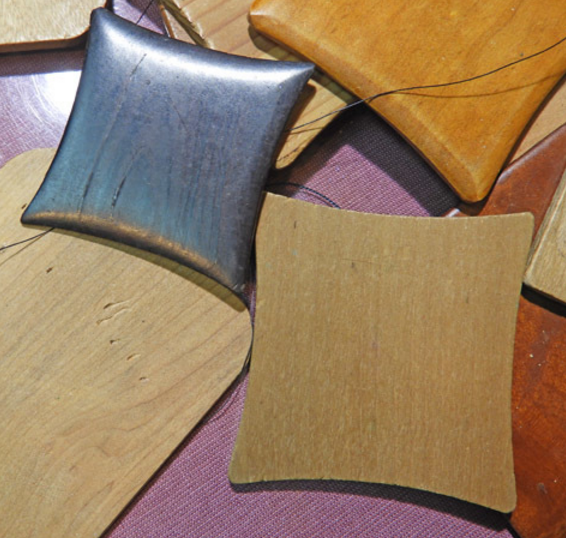
‘the shuriken is shaped like a spool of thread with a square hole inside it that allows it to pull out nails’ *3
Parallel to the appearance of Kosshi jutsu and Senban nage jutsu in China, in the early Heian period in Japan, the Koden Ryu (狐伝流) was created by Fujiwara Kamatari (藤原鎌足). One of the successors of this school, Sakanoue Tamuramaro (坂上田村麻呂), renamed this school Kanze Ryū (観世流) and again, later its name changed further to become Shōshō Ryū (諸賞流), a style whose curriculum included, among other disciplines, shuriken jutsu (手裏剣術).
This in itself is not particularly notable – many ryuha at this time included shuriken jutsu in their repertoire – but there is an interesting link between the Shōshō Ryū and Gyokko/Kotō Ryū styles that is worth considering. The ‘second’ exponent of these schools, Sakanoue Tamuramaro, was not only famous as a folk hero in his time, he is also now considered to be an important figure in the history of the development of the Gyokko/Kotō style as a descendent of founder Chō Bushō *4.
Looking at the known lineages of Tamuramaro's ancestors, it’s hard to see a blood relationship, but Tamuramaro's ancestors were Chinese, originally descending from Achi no Omi (阿知使主). This person was the founder of the Yamatonoaya clan (東漢氏), a powerful family of Chinese and Korean immigrants who settled in Japan and created, among others, the Sakanoue clan (坂上氏).
Let us remember that the relationship between the Sakanoue family and the Kotō Ryū style is not limited to the Heian period. Centuries later, in the Sengoku period (戦国時代), Sakanoue (Sakagami) Tarō Kunishige (坂上太郎国重) appeared as the modern founder of the Kotō Ryū style. Perhaps relations between the Sakanoue family were constant between the Heian and Sengoku periods?
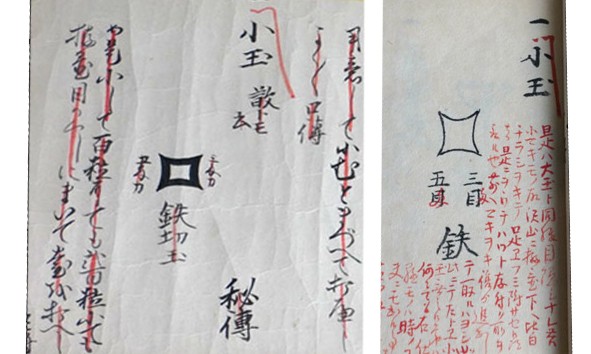
Excerpt from two Shōshō Ryū style documents showing the Kodama (小玉) and its close resemblance to the senban shuriken
The resemblance of the senban shuriken to the simple drawing is quite obvious, but the shuriken jutsu chapter of the book ‘Nihon no Būdō (日本の武道, 手裏剣術)’, includes an image of a Shōshō Ryū style shuriken with a brief description that reads:
‘Shuriken shaped like a thread spool, diameter 9.3cm weight 82gr. Shōshō Ryū’.
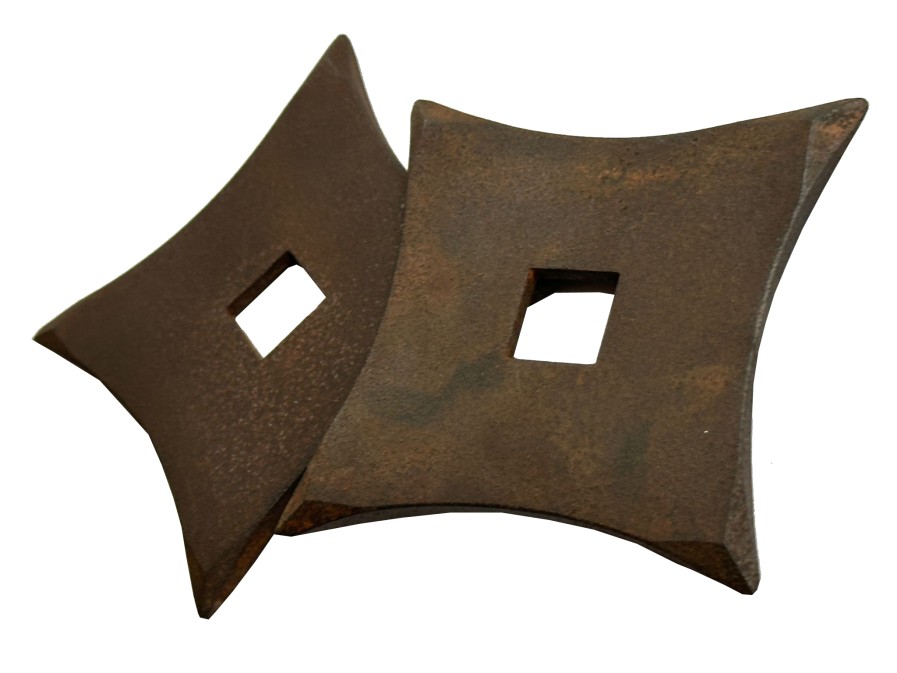
Togakure Ryū Style Shuriken
Knowing precisely when a ryuha added a particular skill to its curriculum is very difficult. For example, when was the shuriken jutsu of the Shōshō Ryū, Gyokko/Kotō Ryū and Togakure Ryū styles incorporated? Was it a speciality of the style or just another section of the mokuroku, or skill catalogue?
Of these three styles Togakure Ryū seems to give the most prominence not just to the skill of throwing metal plates (鉄板, 銛盤投げ術) but also to throwing metal darts (棒手裏剣術) and even to throwing the sword (剣投げ術); this evolution seems to indicate that the Togakure Ryū shinobi must have the ability to effectively throw anything.
September 25th, 2024, Ensanryū 鳶山龍
*1 - 戦国忍法図鑑, author 初見良昭, year 昭和53
*2 - 忍びの武器, author 名和弓雄, year 昭和42
*3 - 忍者忍法画報, author 初見良昭, year 昭和39
*4 - Unarmed fighting techniques of the samurai, author Masaaki Hatsumi, year 2013



